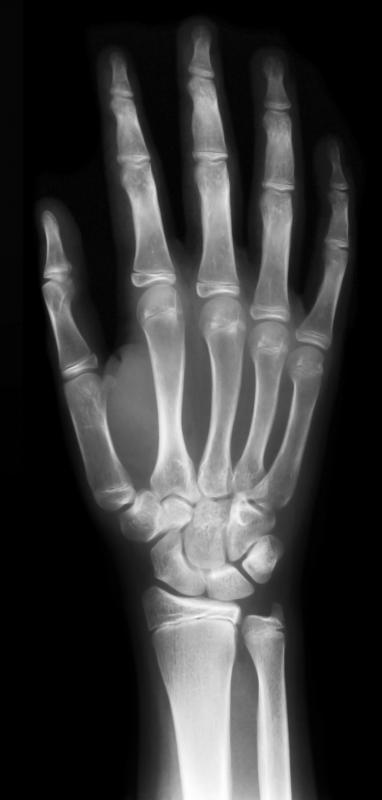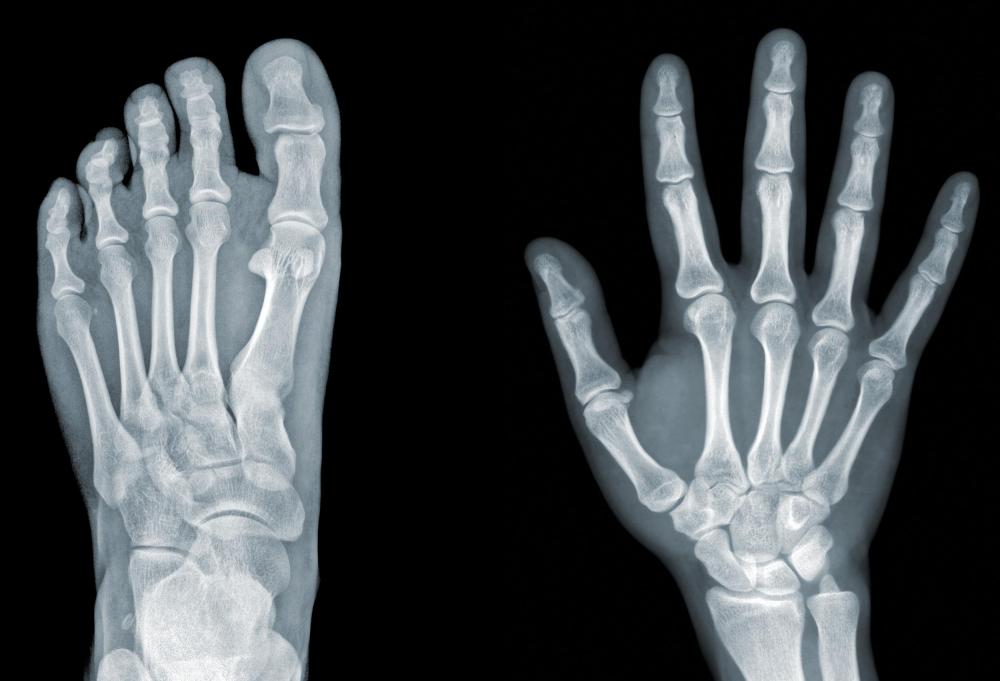At WiseGEEK, we're committed to delivering accurate, trustworthy information. Our expert-authored content is rigorously fact-checked and sourced from credible authorities. Discover how we uphold the highest standards in providing you with reliable knowledge.
What is a Lead Apron?
A lead apron is a protective garment that is designed to shield the body from harmful radiation, usually in the context of medical imaging. Both patients and medical personnel wear these aprons, which are customized for a wide range of usages. As is the case with many protective garments, it is important to remember that it is only effective when it is worn properly and used in a safe and regularly inspected environment. Medical personnel also need to be properly trained in the use of imaging equipment that uses radiation, and untrained personnel are usually not permitted into diagnostic areas that use radioactive imaging techniques.
Lead is well suited for protection from radiation since it is an extremely dense element. It greatly reduces the number of gamma and X-rays that come into direct contact with the body, although a lead apron cannot, of course, stop all such rays. Some consumers may be familiar with this coverage in the form of dental X-ray protection, in which case, it is worn on the body while the teeth are being scanned to protect the patient from radiation scatter.

Since medical personnel may perform large numbers of X-ray procedures every year, they wear aprons to protect themselves from scatter and background radiation. Usually, medical staff also wear tags that monitor their overall level of radiation exposure, which are periodically read to ensure that the staff are not at risk of injury or illness. In the case of medical personnel, full lead protection is worn, since they do not want to expose any part of their bodies to radiation during medical procedures.

Patients, on the other hand, are subjected to X-rays and similar procedures as a diagnostic tool, so they wear incomplete lead shielding that protects parts of the body around the area of interest. This lead shielding often comes in the form of pads that can be arranged as needed. If a pregnant woman needs to undergo an X-ray procedure, she wears a maternity apron that is designed to shield her fetus, due to concern about radiation exposure being extremely harmful to developing babies.

When wearing full lead protection, it is important to make sure that a lead apron fits snugly and securely, and that it does not have rips or tears. Large breasted women in particular need to be careful because they do not want to expose the sides of their breasts to harmful radiation. Since these aprons come in a number of sizes and cuts, there is no reason to be improperly protected. Patients who suspect that they might be pregnant should inform medical personnel when medical imaging is under discussion, so that a doctor can decide whether or not the diagnostic procedure is worth the risk.
AS FEATURED ON:
AS FEATURED ON:
















Discussion Comments
If you get cancer, there is no way to determine if it came from radiation or some other cause. If you google radiation stochastic risks there are many web sites that will explain the difference between stochastic (probalistic) risks and non-stochastic (deterministic or non-probabalistic) risks. The more radiation you get the greater the probability that you will get cancer, but you can never be certain.
@anon152939 - It's true that one x-ray won't cause damage, but we all need to draw the distinction between people who are getting an x-ray and people who are giving x-rays, because the people who are giving x-rays (or working with radiation some other way) are being exposed over and over every day for years and can definitely have adverse effects if they aren't protected.
@anon138122 - I am so sorry that happened to you. I hope you didn't end up with cancer. You really need to stay firm at work, though, how dare they act as though this is your fault?
Any other workplace with that kind of potential dangerous exposure to radiation would have constant seminars on how to deal with it. I mean, when it comes right down to it, what's more expensive, a basic seminar on radiation protection and wearing your lead gear, or the lawsuites that might follow if their workers become sick?
I'm actually really outraged that this hasn't been addressed in your workplace and I hope it changes soon.
A layer as thin as 1/16 inch usually blocks almost 100 percent of radiation types encountered in health care and industrial places.
Great article. I just want to clear up a few points in the comment section.
Starting with Post 1: Yes there is a chance of miscarriage without using a lead apron. It depends on the amount and type of radiation, and how far along you are in pregnancy.
Post 3: Just about anything can block radiation rays, depending on its density. It's the same way light rays can pass through a sheet of paper but not through a wall. We choose lead because of its density. Other metals and materials can be used, but they are more expensive and not as readily available, which is why lead is the leading standard (there are non lead aprons too).
Post 4: Lead aprons are not gauged on thickness, but lead equivalency. Lead aprons can flex and bend because the lead inside them is mixed with other materials like rubber. So the question isn't "how thick does it have to be?" but "how much lead is there mixed into the material?" I hope this was helpful.
There is a lot of ignorance here. The person working in the EP lab is working with high dose exams. There is no way to tell if her swollen lymph node was caused by radiation exposure or some other environmental or physical factor.
There is a ton of radiation exposure evidence that was gathered and still is being gathered from the atomic bombings of Hiroshima and Nagasaki. It would take far more than regular x-ray exposure to cause a miscarriage or genetic damage.
Go to the Health Physics Society site and get some accurate information there.
I have had swollen lymph node removed from my left axillary area. My wrap around lead apron that I've worn for six years on EP lap was not covering my side properly. I never looked down and noticed til I had the swollen lymph node. I had never had radiation safety courses and our radiation badges were not made important to staff. So as a result we all had/have very a non-caring attitude towards the hazardous material we work with daily.
I didn't wear my badges properly or store them properly. I worked with EP doctor that repeatedly has the highest levels of exposure to radiation. I write all this to urge our women Cath Lab workers to please take the time to self evaluate how your lead fits around your breasts. I feel very stupid that I didn't catch this and now I am facing the recovering of surgery and diagnosis.
When I brought this up to management I became the bad guy. My co-workers were even upset with me for "rocking the boat." But I cannot help but feel angry that our Cath Lab didn't put any focus on radiation safety and if I had only been made aware - I might have avoided this. I don't have cancer in my family. And hoping for good results.
How thick does the lead apron have to be?
How does this protect you from radiation?
Of course there is!
is there any chances of having a miscarriage because of not wearing a lead apron?
Post your comments